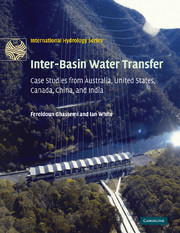Book contents
- Frontmatter
- Contents
- Foreword
- Overview and Scope
- Acknowledgements
- List of Abbreviations
- Part I The Challenges
- Part II Inter-basin Water Transfer in Australia
- Part III Inter-basin Water Transfer in Other Selected Countries
- 11 Inter-basin water transfer in the United States of America
- 12 Inter-basin water transfer in Canada
- 13 Inter-basin water transfer in China
- 14 India: The National River-Linking Project
- 15 Inter-basin water transfer, successes, failures and the future
- Part IV Appendices
- Glossary
- Index
- References
14 - India: The National River-Linking Project
Published online by Cambridge University Press: 05 November 2009
- Frontmatter
- Contents
- Foreword
- Overview and Scope
- Acknowledgements
- List of Abbreviations
- Part I The Challenges
- Part II Inter-basin Water Transfer in Australia
- Part III Inter-basin Water Transfer in Other Selected Countries
- 11 Inter-basin water transfer in the United States of America
- 12 Inter-basin water transfer in Canada
- 13 Inter-basin water transfer in China
- 14 India: The National River-Linking Project
- 15 Inter-basin water transfer, successes, failures and the future
- Part IV Appendices
- Glossary
- Index
- References
Summary
OVERVIEW OF GEOGRAPHY, POPULATION, LAND AND WATER
GEOGRAPHY
India is a vast country covering an area of about 3 287 726 km2. It measures 2980 km from east to west and 3220 km from north to south. India has the following principal physiographic regions (Figure 14.1).
The Himalaya Mountains with Mt Everest the world's highest peak at 8848 m, run for more than 2400 km along the northern frontiers of India. Numerous peaks of Himalaya with elevations of above 7700 m are within India.
The Indo-Gangetic Plains in the south and parallel to the Himalaya Mountains, comprise a belt of flat alluvial lowlands. The average elevation is less than 150 m above mean sea level. These plains are watered by three distinct river systems: the Indus, the Ganga, and the Brahmaputra. The Indus River drains through Pakistan into the Arabian Sea, while the other two have their outfall in the Bay of Bengal.
The Great Indian Desert is an arid region in the north-western part of the country and contains large tracts of fertile soils. The Indira Gandhi Canal diverts tributaries of the Indus River to these areas.
The Deccan Plateau in the south of the Indo-Gangetic Plains, is a vast triangular tableland occupying most of the Indian Peninsula. It is a generally uneven plateau naturally divided into regions by low mountain ranges and deep valleys. The elevation of the plateau ranges mainly from about 305 to 915 m, with a highest peak of 2134 m.
[…]
- Type
- Chapter
- Information
- Inter-Basin Water TransferCase Studies from Australia, United States, Canada, China and India, pp. 319 - 344Publisher: Cambridge University PressPrint publication year: 2007



